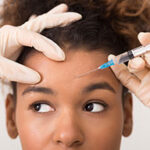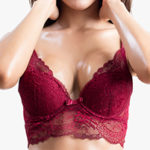Injectable Fillers Washington DC
If you are considering injectable fillers
As we age, our faces begin to show the effects of gravity, sun exposure, and years of facial muscle movement, such as smiling, chewing, and squinting. The underlying tissues that keep our skin looking youthful and plumped up begin to break down, often leaving laugh lines, smile lines, crow’s feet, or facial creases over the areas where this muscle movement occurs. Soft-tissue fillers, most commonly injectable collagen, hyaluronic acid, or fat, can help fill in these lines and creases, temporarily restoring a smoother, more youthful-looking appearance.
When injected beneath the skin, these fillers plump up creased and sunken areas of the face. They can also add fullness to the lips and cheeks. Injectable fillers may be used alone or in conjunction with a resurfacing procedure, such as a laser treatment, or a recontouring procedure, such as a facelift.
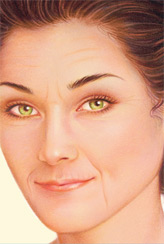

Injectable fillers can help improve the skin’s texture by filling in the laugh lines and facial creases that often occur with aging.
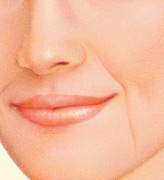
Years of squinting, smiling and other facial muscle movements can lead to lines and wrinkles around the mouth and nose.
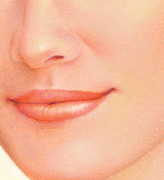
After treatment, the skin around the mouth area appears smoother and tauter.
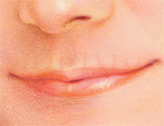
The lips can become thinner or flatter over time.
Soft tissue augmentation of the lips can enhance lip fullness and raise or define the cupid’s bow or vermillion border.
Dr. Baker’s credentials:
- Professor of Plastic Surgery, Medstar Georgetown University Hospital
- Former Allergan Facial Aesthetics Trainer
- Former member, Allergan Fat Grafting Expert Group
- Previous NIH-funded research in fat grafting
- Published patient satisfaction studies on facial aesthetics and dermal fillers
- Published studies on fat grafting in facial surgery
Facile in BOTH nonsurgical and surgical rejuvenation-as aging progress treating folds and creases with fillers leads to an overfilled, cherubic, steroid appearance. As a plastic surgeon, Dr. Baker has other options in his treatment regimen. He will tell you when an alternative to fillers may produce a more aesthetic result.
What are the different types of fillers?
Hyaluronic Acid (Juvederm, Restylane, Voluma, Belotero) is a natural substance found in our bodies. It is well suited to plump thin lips and fills facial creases such as nasolabial folds. It may also be appropriate for some surface wrinkles and concave scars. The results may last 6 months or longer.
Human fat, harvested from your own body, can be reinjected to enhance facial fullness, fill deep creases, and build up shallow contours. Fat injection requires a more extensive procedure than other injectable fillers because it uses liposuction techniques to extract the fat prior to injection.
What to Expect from Treatment
The most important fact to remember about injectable fillers is that the results are not permanent, nor do you want the results to be permanent. The amount and location of filler that is injected today will be different than what you will need ten years in the future. It is best to be able to titrate each patient’s treatment to their desires and needs as they age. Facial aging is a dynamic process and the treatment plan should take that into consideration. This is the reason Dr. Baker tends to avoid permanent fillers. Fat transfer is the one exception to this but fat has different indications in Dr. Baker’s practice.
Injected material is eventually metabolized by the body. You should not expect the same long-lasting results that may be gained from cosmetic surgery.
In some individuals, the results may last only a few weeks; in others, the results may be maintained indefinitely. Research has shown that age, genetic background, skin quality, and lifestyle, as well as the injected body site, may all play a role in the injected material’s longevity. However, the precise reason for the variation of results among patients has yet to be identified.
If you have had short-lived results from fat injections, you should not necessarily assume that dermal fillers will work better for you. Conversely, if you have had disappointing results from dermal fillers, do not assume that injected fat is the answer. Although it is true that some individuals’ bodies are more receptive to one substance than the other, others may find that neither substance produces long-lasting results. Sometimes one substance may work better than the other for a specific problem.
I’m extremely pleased with my results!! I’m on cloud nine!
“Dear Dr. Baker, no words can truly convey how grateful I am to have met you and for the exceptional work you did on me. I’m extremely pleased with my results!! I’m on cloud nine!
I’m sure many others before me have said this but I have to say that you are such a kind and an extraordinarily gifted plastic surgeon with the best bed side manner and incredible ability to make patients feel at ease. You are amazing and I am in awe of your talents. My mom was right when she said “Dr. French would only refer me to the very best”.
I also wanted to thank your extremely knowledgeable and caring staff. Kudos to Laurie Sladek, Cathalene Blake, and Laura Seiboth for treating me with the utmost respect and kindness. You and your staff exemplify excellence in healthcare, and I unequivocally recommend anyone to seek out your services.
Dr. Baker, I’m forever indebted to you and I’ll never forget you”
Risks related to injectables
When injectables are administered by a qualified plastic surgeon, complications are infrequent and usually minor in nature. Still, individuals vary greatly in their anatomy, their physical reactions and their healing abilities. The outcome of treatment with injectables is never completely predictable.
Hyaluronic acid: side effects are typically mild or moderate in nature and last for less than 7 days. Adverse events include redness, pain, firmness, swelling, lumps/bumps, bruising, itching, and discoloration.
Fat: Allergic reaction is not a factor for fat because it is harvested from a patient’s own body. However, there is still a small risk of infection and other infrequent complications.
Planning for treatment
Facial rejuvenation is very individualized. That is why it is important to discuss your hopes and expectations with Dr. Baker, who has experience with many different types of surgical and non-surgical facial procedures. In your initial consultation, Dr. Baker will evaluate your face – the skin, the muscles, and the underlying bone – and discuss your goals for the surgery. Dr. Baker will help you select a treatment option based on your goals and concerns, your anatomy, and your lifestyle. Dr. Baker will ask you about your medical history, and drug allergies, and check for conditions that could cause problems, such as active skin infections or non-healed sores from injuries.
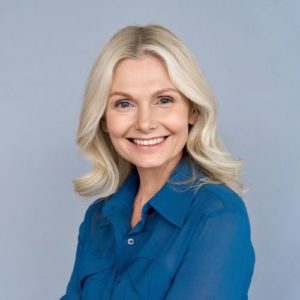 Where Your Treatment Will Be Performed
Where Your Treatment Will Be Performed
Injectables are usually administered in Dr. Baker’s office. If, however, you are being hospitalized for a facelift, neck lift, brow lift, or any other procedure, your injections may be administered in the hospital as well.
Types of Anesthesia
In fat grafting both the donor and recipient sites are numbed with local anesthesia, but IV sedation is a useful adjunct for the more involved cases of fat grafting. If you elect to use sedation, be sure to arrange for a ride home after your treatment.
Hyaluronic Acid (Juvederm, Restylane, Voluma, Belotero)
Hyaluronic acid (HA) is a naturally occurring protein that supports the connective tissue of the body. Injectable HA is derived from recombinant DNA to synthesize HA. The purification process ensures the product is similar to human HA. Injectable HA is produced with varying degrees of cross-linking to produce products with different viscosity and longevity.
HA is used primarily to fill wrinkles, lines, and scars on the face. Local anesthesia can be used to control discomfort as the injections are administered, and many of the fillers have local anesthetic mixed with the product to minimize discomfort. Many patients elect to have a numbing cream placed on the skin to be injected about 30 minutes prior to injection to further minimize discomfort. The effect of an injectable HA is immediate and Dr. Baker frequently has the patient hold the mirror so they can see the results and determine if they would like any additional filler.
After treatment, you may notice some minor discomfort in the injected area. Occasionally some bruising or swelling will occur, but it is usually minor. No bandaging is needed and you are free to eat, drink, and wear makeup with sunblock protection shortly thereafter. There may be some temporary swelling and redness in the treated area which should dissipate within a few days. If these symptoms persist, contact Dr. Baker.
The duration of your results will vary based on the product and location injected. In general, the injected material is likely to disappear faster in areas that are more affected by muscle movement. Dr. Baker can help you determine how long you can go between treatments to best maintain your results.
Fat Injection
The fat-injection procedure is also known as autologous fat transplantation or micro-lipoinjection. Fat cells are extracted from the patient’s abdomen, thighs, buttocks, or elsewhere and reinjected beneath the facial skin. Fat can fill in sunken cheeks or lines between the nose and mouth, correct skin depressions, minimize forehead wrinkles, or enhance the lips.
After cleansing and treatment with local anesthesia, fat is withdrawn using a syringe with a large-bore needle or a liposuction cannula. The fat is then prepared and injected into the recipient site with a needle. Sometimes an adhesive bandage is applied over the injection site. Slight overfilling may be necessary to allow for fat absorption that occurs. When fat is used to augment the cheeks, this overcorrection may cause the face to appear abnormally full.
While some treatments require a brief recovery period, many patients resume normal activity right away. Expect some swelling, bruising, or redness in both the donor and recipient sites. The severity of these symptoms depends upon the size and location of the treated area. Stay out of the sun until redness and bruising subside – usually about 48 hours. In the meantime, you may use makeup with sunblock protection to help conceal your condition. In some cases, swelling and puffiness in the recipient site last several weeks, especially if a large area was filled.
While some patients report results lasting 1 year or more, the majority of patients find that at least half of the injected fullness disappears within 3-6 months. Therefore, repeated injections may be necessary. Dr. Baker will advise you on how to maintain your results with repeat treatments.
Nonsurgical (Filler) Rhinoplasty
Fillers offer a method to make subtle changes to nasal form either in primary or revision rhinoplasty. In areas that are under contoured, a filler is injected in the office to add volume or definition in nasal form without the need for anesthesia and surgery. Filler is used to enhancing symmetry, increase subtle degrees of nasal tip projection, and elevate the bridge of the nose. While filler is useful in subtle changes, it is important to note that the structure of the nose is cartilage and bone. Therefore large degrees of dimensional change created with filler will give the nose a soft, doughy appearance that is inconsistent with normal nasal form.
Mohs Surgery
What is Mohs Surgery? Mohs surgery is a technique where a dermatologist is trained in reviewing the pathology of a skin lesion as it is being excised to determine whether the lesion has been entirely removed or if some of the skin cancer remains. If the Mohs surgeon sees that some skin cancer remains, he/she will make subsequent small re-excisions until the cancer is completely excised. This technique was originally designed for excisions of basal and squamous cell carcinomas in anatomic areas where it is important to minimize the amount of normal tissue removed such as the nose, ears, or eyelid.
What is the role of the Mohs surgeon? Mohs surgery is the subspecialty of dermatology that has expertise in reading the pathology of the skin specimens as they are excised. Although the term surgery is used in the term Mohs surgery, Mohs surgery is not a surgical specialty recognized by the American College of Surgeons.
Is every skin cancer best treated with Mohs surgery? Mohs is not the best option from a cosmetic point in many cases of skin cancer because, by definition, Mohs surgery removes all cancer at one stage. In many cases, especially on the face, a staged excision performed in the plastic surgeon’s office results in a much smaller scar. Since it is extremely rare for cutaneous basal cell or squamous carcinoma to metastasize, there is no rush to remove the lesion in one stage. For example, Dr. Baker sees many children with large moles on their faces and body. In many of these cases, he could remove the entire mole in one stage (similar to Mohs surgery), but he elects to remove the mole in a series of smaller steps to keep the scar as small as possible. By using several smaller steps the final scar is much less than that of a flap that is required to close a Mohs defect. Remember Mohs surgery was developed to minimize the removal of normal tissue when removing skin cancer not as a technique to remove the entire lesion in one step.
How do I get a Plastic Surgery closure if I want to use a Mohs surgeon to remove the cancer? If a patient desires a plastic surgeon to close the wound left after Mohs surgery, he/she can arrange both procedures so the Plastic Surgery closure is done the same day or the day after the Mohs surgeon removes the lesion. For a patient with skin cancer in the eyelid, nose, or ear this combined approach optimizes the patient’s outcome by combing the expertise of a Mohs surgeon who removes cancer with minimal damage to normal tissue and a plastic surgeon whose surgical expertise achieves an excellent aesthetic outcome.
 Your New Look
Your New Look
If you are like most patients, you will be very satisfied with the results of your injectable treatments. You may be surprised at the pleasing results that can be gained from this procedure.
How Much Does Injectable Fillers Cost?
The cost of an Upper Arm Lift will depend on several factors. The price can be affected by body type, type of technique performed, surgical complications, and even allergies. Find out more by scheduling a consultation.
Schedule an Injectable Fillers Consultation
If you have any questions about Injectable Fillers in Washington DC or would like to book a consultation with Dr. Baker, please contact Dr. Baker today. Our skilled team can help you get the sculpted body you have always desired.






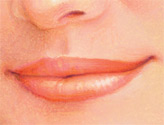
 Where Your Treatment Will Be Performed
Where Your Treatment Will Be Performed Your New Look
Your New Look